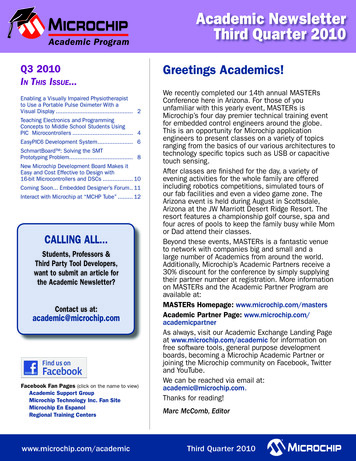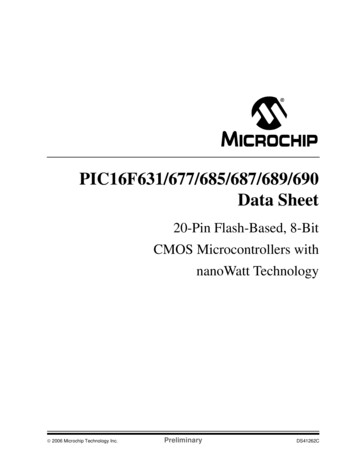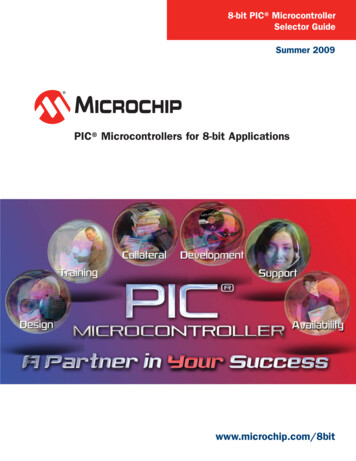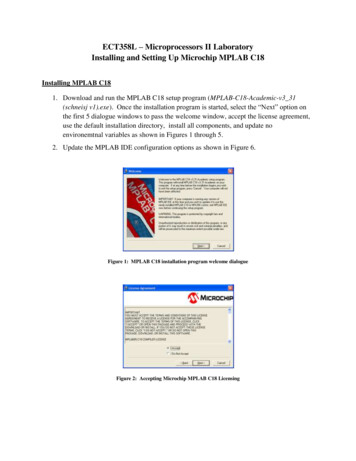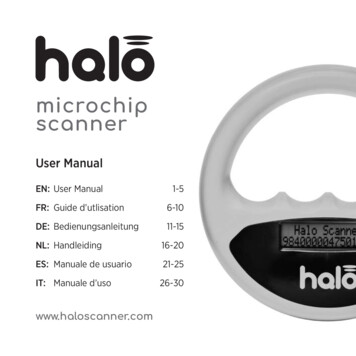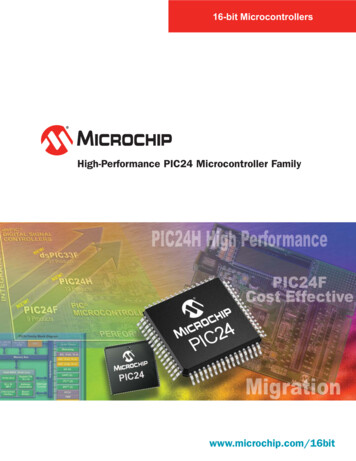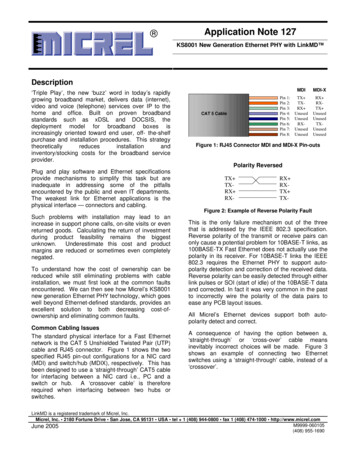
Transcription
Application Note 127KS8001 New Generation Ethernet PHY with LinkMD Description‘Triple Play’, the new ‘buzz’ word in today’s rapidlygrowing broadband market, delivers data (internet),video and voice (telephone) services over IP to thehome and office. Built on proven broadbandstandards such as xDSL and DOCSIS, thedeployment model for broadband boxes isincreasingly oriented toward end user, off- the-shelfpurchase and installation procedures. This ry/stocking costs for the broadband serviceprovider.Pin 1:Pin 2:Pin 3:Pin 4:Pin 5:Pin 6:Pin 7:Pin 8:CAT 5 CableMDIMDI-XTX TXRX UnusedUnusedRXUnusedUnusedRX RXTX UnusedUnusedTXUnusedUnusedFigure 1: RJ45 Connector MDI and MDI-X Pin-outsPolarity ReversedPlug and play software and Ethernet specificationsprovide mechanisms to simplify this task but areinadequate in addressing some of the pitfallsencountered by the public and even IT departments.The weakest link for Ethernet applications is thephysical interface — connectors and cabling.TX TXRX RX-RX RXTX TX-Figure 2: Example of Reverse Polarity FaultSuch problems with installation may lead to anincrease in support phone calls, on-site visits or evenreturned goods. Calculating the return of investmentduring product feasibility remains the biggestunknown.Underestimate this cost and productmargins are reduced or sometimes even completelynegated.To understand how the cost of ownership can bereduced while still eliminating problems with cableinstallation, we must first look at the common faultsencountered. We can then see how Micrel’s KS8001new generation Ethernet PHY technology, which goeswell beyond Ethernet-defined standards, provides anexcellent solution to both decreasing cost-ofownership and eliminating common faults.Common Cabling IssuesThe standard physical interface for a Fast Ethernetnetwork is the CAT 5 Unshielded Twisted Pair (UTP)cable and RJ45 connector. Figure 1 shows the twospecified RJ45 pin-out configurations for a NIC card(MDI) and switch/hub (MDIX), respectively. This hasbeen designed to use a ‘straight-through’ CAT5 cablefor interfacing between a NIC card i.e., PC and aswitch or hub. A ‘crossover cable’ is thereforerequired when interfacing between two hubs orswitches.This is the only failure mechanism out of the threethat is addressed by the IEEE 802.3 specification.Reverse polarity of the transmit or receive pairs canonly cause a potential problem for 10BASE-T links, as100BASE-TX Fast Ethernet does not actually use thepolarity in its receiver. For 10BASE-T links the IEEE802.3 requires the Ethernet PHY to support autopolarity detection and correction of the received data.Reverse polarity can be easily detected through eitherlink pulses or SOI (start of idle) of the 10BASE-T dataand corrected. In fact it was very common in the pastto incorrectly wire the polarity of the data pairs toease any PCB layout issues.All Micrel’s Ethernet devices support both autopolarity detect and correct.A consequence of having the option between a,‘straight-through’ or ‘cross-over’ cable meansinevitably incorrect choices will be made. Figure 3shows an example of connecting two Ethernetswitches using a ‘straight-through’ cable, instead of a‘crossover’.LinkMD is a registered trademark of Micrel, Inc.Micrel, Inc. 2180 Fortune Drive San Jose, CA 95131 USA tel 1 (408) 944-0800 fax 1 (408) 474-1000 http://www.micrel.comM9999-060105June 2005(408) 955-1690
Micrel, Inc.KS8001 Application Note 127calculate the impedance mismatch and hence identifyif a fault exists down the cable. Figures 5 and 6 showexamples of the reflected waveform for various faultconditions.1. Crossed-PairsTX TXRX RX-TX TXRX RX-Source WaveformReflected WaveformFigure 3: Example of Crossed Pairs FaultAutomatic MDI/MDI-X is designed to eliminate theneed for crossover cables between similar devices.The KS8001 PHY family implements the HP Autocrossover algorithm, which will internally swap thetransmit and receive pairs so that they correctlyinterface to the link partner, dependent upon the typeof cable used.VRRound Trip Propagation DelayFigure 5: Source and Reflected Waveforms of anincorrectly terminated cableThe Reflection Coefficient, ρL, defined as the ratio ofthe amplitude of the reflected wave and the amplitudeof the incident wave is calculated as;Indeed, to avoid cable installation problems,automatic crossover is the, ‘must have’ feature in anyapplication today.ρL VR (reflected wave) ZL - Zo2. Open / Short CircuitTX TXRX RX-XXRX RXTX TX-TX TXRX RX-VI (incident wave)RX RXTX TX-Z L ZoWhere ZL is the load impedance and Zo is the cableimpedance, which is 100 ohms for a CAT5 cable.By applying this formula a fault can easily beidentified.Figure 4: Example of Open & Short Circuit FaultsIf ZL 0, then ρL -1 (short)The final common cable failure condition is open orshort circuits, which can be caused by a magnitude ofdifferent events. An open circuit may simply be theresult of someone inadvertently removing or forgettingto connect the cable. It might also be the result of adamaged cable. In the home, a RJ-45 Ethernetsocket is easily mistaken for the standard RJ-11telephone socket when installing DSL modems or SetTop boxes. Often, in larger office installations, theconnector/cable is assembled in-situ, resulting in allmanner of faults, including open, short circuits.If ZL 100, then –1 ρL 0 (incorrect termination)If ZL 1000, then ρL 0 (correct termination)If ZL 100, then 0 ρL 1 (incorrect termination)If ZL 100, then ρL 1 (open)Hence, for a perfect terminated cable, then ρL 0 andno reflection occurs. In reality there will be someslight imperfections so an attenuated reflection willalways be seen.LinkMD Cable DiagnosticsMicrel’s KS8001 family is the industry’s first singleport PHY to provide full cable diagnostics. LinkMD utilizes time domain reflectometry (TDR) to analyzethe cabling plant for these common cable problems,such as open circuits, short circuits and impedancemismatches.The significance of the negative unity reflectioncoefficient, for a short-circuit condition, is that thereflection will be reversed polarity and equalamplitude relative to the incident pulse, as shown inFigure 6a.Likewise for an open-circuit condition, the reflectedwaveform is of equal amplitude and polarity to theincident waveform (figure 6b), resulting in a ρL 1.When a pulse of known amplitude and duration isinjected down a cable pair, a reflected pulse will bereturned. The reflection is caused by the impedancemismatch at the fault or load termination. Theamplitude of the reflection can be analyzed toJune 2005Time2M9999-060105(408) 955-1690VI
Micrel, Inc.KS8001 Application Note 127Source WaveformReflected WaveformUsing this specification, we can easily calculate thelength of cable or distance to fault by measuring thepropagation delay of the reflected waveform. Fromthe afore listed calculation, we can see that a usefulrule of thumb for cable length is: 5nS propagationdelay per meter of cable (remember to halve theround trip propagation delay when calculatingdistance).For example, Figure 6b shows thepropagation delay of a reflected waveform for a 90mCAT5 cable (open-circuit). Hence, to calculate thedistance to fault:VIVR800nSa) 80m cable, short-circuitDistance (Propagation Delay in nS)VI VR2 x 5nS/mwith a propagation delay 900nS, then distance tofault 90m.900nSb) 90m cable, open-circuitMicrel’s KS8001 PHY implements the delaymeasurement using an internal 9-bit counteroperating at a frequency of 250MHz (4nS clockperiod). This will provide fault diagnostics up to amaximum of 200m. Calibration of the VOP for aspecific cabling plant can result in accuracy of: /1m.VRVIFor short cables, as shown in Figure 6c, the reflectedwave will be superimposed onto the original incidentwaveform. This is a result of the propagation roundtrip delay being less than the incident pulse period.100nS20nSIncident Waveform Period (100nS) Cable length x5nS/m x 2c) 2m cable, open-circuitFigure 6: Examples of Source and Reflected Waveforms foropen and short-circuit cables of various lengthsHence, this condition will arise for cable lengths orfault distances less than 10m. Here, Micrel’s KS8001provides an extra register bit for additional accuracyover such short distances.Calculating Fault DistanceVelocity of Propagation (VOP) is a specification thatprovides the speed of a signal, down a given cable,relative to the speed of light in a vacuum (3.0 x 108m/s). The VOP specification will not only varydependent upon the type of cable, but also themanufacturer. The VOP of a CAT5 cable is usuallyaround 0.66. This means that a signal will traveldown a CAT5 cable at a speed of 0.66 x 3.0 x 108 m/s 2 x 108 m/s.June 20053M9999-060105(408) 955-1690
Micrel, Inc.KS8001 Application Note 127The need for expensive ethernet test equipment iseliminated by the addition of on-board USB toEthernet (MII) conversion, providing a complete testsuite using only a PC, as shown in Figure 8. Cablediagnostics and basic traffic error testing can both beperformed in this configuration. Alternatively, industrystandard (e.g. Spirent SmartBits) external testequipment can interface via the MII connector directlyto perform full verification and compliance testing.KS8001 Development KitThe KS8001 development kit provides both theLinkMD software and a unique evaluation board,enabling faster time to market. The LinkMD GUI,shown in Figure 7, provides full access to theKS8001’s internal register map and cable diagnosticfeature, via the USB interface. Example source istance to fault, is available tocustomers, free of charge, allowing fast, simplesystem integration.KS8001MIICAT5(To PC)USB(To PC)Figure 8: KS8001 Evaluation BoardConclusionAs Ethernet continues to grow, not just in the office,but in the home and elsewhere, the need for ‘smart’physical transceivers are essential for ‘plug-and-play’installation and low cost maintenance. Traditionally, anetwork’s weakest link has always been the physicalinterface. With the support of automatic crossoverand the advent of LinkMD cable diagnostics,Micrel’s KS8001 new generation lowest power SinglePort PHY can significantly reduce the cost ofownership, enabling increased manufacturer revenuemargins.For more information on the KS8001 or any other ones@micrel.co.ukFigure 7: Micrel’s LinkMD Software GUIJune 20054M9999-060105(408) 955-1690
Micrel, Inc.KS8001 Application Note 127MICREL, INC. 2180 FORTUNE DRIVE SAN JOSE, CA 95131 USATEL 1 (408) 944-0800 FAX 1 (408) 474-1000 WEB http:/www.micrel.comThis information furnished by Micrel in this data sheet is believed to be accurate and reliable. However no responsibility isassumed by Micrel for its use. Micrel reserves the right to change circuitry and specifications at any time without notification tothe customer.Micrel Products are not designed or authorized for use as components in life support appliances, devices or systems wheremalfunction of a product can reasonably be expected to result in personal injury. Life support devices or systems are devices orsystems that (a) are intended for surgical implant into the body or (b) support or sustain life, and whose failure to perform can bereasonably expected to result in a significant injury to the user. A Purchaser's use or sale of Micrel Products for use in lifesupport appliances, devices or systems is a Purchaser's own risk and Purchaser agrees to fully indemnify Micrel for anydamages resulting from such use or sale. 2005 Micrel IncorporatedJune 20055M9999-060105(408) 955-1690
telephone socket when installing DSL modems or Set Top boxes. Often, in larger office installations, the . Distance (Propagation Delay in nS) 2 x 5nS/m with a propagation delay 900nS, then distance to . michael.jones@micrel.co.uk . Micrel, Inc. KS8001 Application Note 127 June 2005 M9999-060105 (408) 955-1690 5
